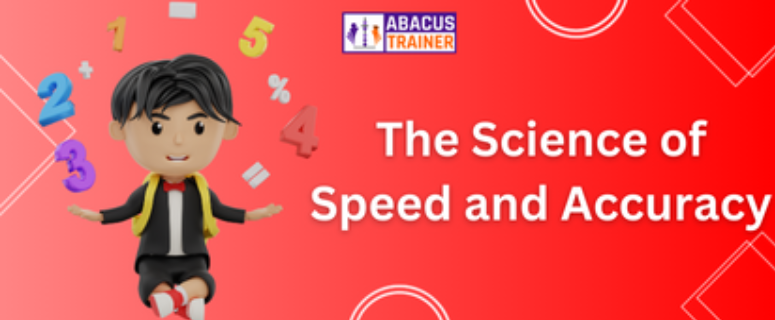The Science of Speed and Accuracy: Abacus Math Techniques
The abacus is a centuries-old mathematical tool that, while seemingly simple, relies on scientific principles related to speed and accuracy in mental calculations. Here's a closer look at the science behind the speed and accuracy of the abacus
About The Science of Speed and Accuracy: Abacus Math Techniques
Visual and Spatial Processing
The abacus leverages the brain's ability for visual and spatial processing. When using the
abacus, users visualize numbers and their positions on the counting frame.
The arrangement of beads on the abacus rods represents numerical values, and users
mentally manipulate these beads to perform calculations. This spatial processing enhances
the accuracy of calculations.
Subitizing
Subitizing is the ability to recognize the number of objects in a set without counting them
individually. The abacus encourages subitizing by allowing users to quickly grasp the value of the beads on each rod.
This skill promotes fast recognition of numbers and reduces the need for time-consuming
counting, contributing to calculation speed.
Muscle Memory and Motor Skills
Using the abacus involves fine motor skills and muscle memory. As users move beads up and
down, they develop muscle memory for common calculations.
Over time, these movements become second nature, leading to quicker and more accurate
calculations.
Place Value and Decimal System
The abacus is an excellent tool for teaching and reinforcing the concept of the decimal
system and place value.
Users learn to represent numbers by placing beads in specific positions, making it easier to
understand and work with numbers in a structured and systematic manner.
Multisensory Learning
The abacus provides a multisensory learning experience, engaging multiple senses
simultaneously. Users see the beads, touch and manipulate them, and even hear the distinct
sound they make when moved.
This multisensory approach enhances memory and aids in retaining mathematical concepts,
leading to improved accuracy.
Mental Calculation Strategies
The abacus encourages the development of mental calculation strategies. Users learn to
perform arithmetic operations mentally, without the need for external aids like pen and paper
or calculators.
By internalizing calculation techniques and strategies, individuals can perform calculations
quickly and accurately.
Concentration and Focus
Using the abacus demands high levels of concentration and focus. This increased attention
helps reduce errors and improves accuracy. Concentration also leads to faster calculations, as
distractions are minimized.
Abacus Math Techniques
Abacus math techniques involve using the abacus, a counting tool with rows of beads or
counters on rods, to perform various arithmetic calculations. The abacus is an ancient device
that facilitates mental calculations and is particularly effective for teaching and reinforcing
fundamental math skills. Here are some common abacus math techniques:
Representation of Numbers
Each row on the abacus represents a different place value (ones, tens, hundreds, etc.). The
beads on each rod represent numerical values. Users place beads in specific positions to
represent numbers.
The rightmost rod represents the ones place, the next rod to the left represents tens, the
following rod hundreds, and so on.
Addition
To perform addition on the abacus, you start by representing the two numbers to be added
on the abacus by placing beads in their respective positions.
Then, to add, you slide beads upward to group them together, making it easy to determine the
sum. Carry-over is performed when necessary by moving beads to the left.
The sum is read directly from the abacus after performing these movements.
Subtraction
Subtraction on the abacus is the reverse of addition. You start with the larger number
represented on the abacus.
To subtract, you slide beads downward to separate the numbers. Borrowing may be
necessary to handle situations where subtraction leads to a negative result.
The difference is read directly from the abacus after these movements.
Multiplication
Multiplication on the abacus involves representing both the multiplicand and the multiplier.
You then manipulate the beads to perform multiplication.
For each digit in the multiplier, you multiply it by each digit in the multiplicand, placing the
results in their respective positions.
You sum these partial products to obtain the final product.
Division
Division on the abacus is more complex and involves representing the dividend and divisor.
You repeatedly subtract the divisor from the dividend, keeping track of the quotient as you
go.
The quotient is built up as you divide, and the remainder can be determined from the final
state of the abacus.
Square Roots and Cube Roots
The abacus can also be used to find square roots and cube roots. The techniques involve
various steps of approximation and iteration to arrive at the result.
Decimal Arithmetic
The abacus is highly versatile and can handle decimal arithmetic as well. It involves
representing both whole numbers and decimals on the abacus and applying the same
techniques for addition, subtraction, multiplication, and division.
Conclusion
Abacus math techniques offer a structured and systematic approach to arithmetic that helps
users understand the principles of place value, develop strong mental math skills, and
improve concentration and focus. These techniques can be especially useful for children
learning math and for individuals looking to enhance their mathematical proficiency.












